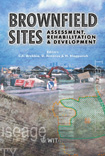The Coupled Effect Of Electrokinetic And Ultrasonic Remediation Of Contaminated Soil
Price
Free (open access)
Transaction
Volume
55
Pages
Published
2002
Size
716 kb
Paper DOI
10.2495/BF020491
Copyright
WIT Press
Author(s)
H. I. Chung, I. K. Oh & M. Kamon
Abstract
The coupled effect of electrokinetic and ultrasonic remediation of contaminated soil H.I. Chung1, I.K. Oh1 & M. Kamon2 1Department of Civil Engineering, Korea Institute of Construction Technology, Korea 2DPRI, Kyoto University, Japan Abstract The laboratory tests were conducted using specially designed and fabricated devices to determine the effect of sonication and electrohnetics on seepage as well as on contaminant removal in contaminated soil. The electrolunetic technique was applied to remove mainly the heavy metal and the ultrasonic technique was applied to remove mainly organic substance in contaminated soil. Test soil was Jumunjin (East beach of Korea) fine sand; the test specimen was prepared at loose density. Diesel fuel and Cd were used as a surrogate contaminant for soil flushing test. A series of laboratory experiments involving the simple, ultrasonic, electrolunetic, electrokinetic + ultrasonic flushing test were carried out. An increase in permeability and contaminant removal rate was observed in electrohnetic and ultrasonic flushing tests. Some practical implications of these results are discussed in terms of technical feasibility of in situ implementation of electrolunetic ultrasonic remediation technique. 1 Introduction The contaminated ground can be removed and replaced with non-polluted soils. This method requires installations of sheet-pile walls to protect the surrounding ground. The execution of this method is costly and may also interrupt the ongoing business. Therefore, it is always more desirable to clean up the pollutant in situ than to remove the contaminated soil. In response to the demand for developing effective and economical cleanup techniques, numerous studies have been conducted over the years. Several clean-up techniques have been
Keywords




